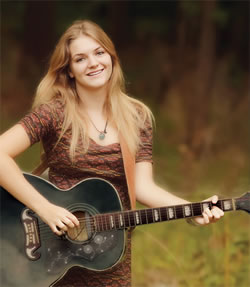Chicken, turkey and tuna. Rice and wheat. Strawberries, blueberries, avocados and grapes. Spinach, lettuce, onions and sweet potatoes. Green beans, if they’re cooked a certain way.
 This is a complete list of what 17-year-old Haley Bauser is allowed to eat.
This is a complete list of what 17-year-old Haley Bauser is allowed to eat.
Surprisingly, she doesn’t mind. It’s either stick to that restricted diet or return to the debilitating pain that set in when she was just a baby.
Haley has eosinophilic esophagitis, EoE for short. “I didn’t realize how much pain I’d been living with,” she says, “until I was diagnosed and started getting the right treatment.”
EoE is a chronic condition triggered by allergies to certain foods that differ for each patient. When an EoE patient eats those foods, the body reacts by producing eosinophils, a type of white blood cell, in the esophagus. High numbers of eosinophils inflame the surrounding tissue, resulting in constant pain, growth problems, nausea, vomiting and problems swallowing. EoE’s cause is unknown, but many with the condition have other allergic disorders, such as asthma or nasal allergies, both of which Haley also has.
Haley’s mother, Charlotte Bauser, works at Dam Neck as command network manager for the Navy’s Combat Direction Systems Activity. She remembers the relentless colic, or at least that’s what she thought it was, that came on when Haley was 2 weeks old. “As a baby, she was in so much pain that her legs would draw up,” Charlotte says. “It never went away. Back then, the doctors said it was reflux.”
Haley’s chest and stomach pain grew progressively worse through her elementary and middle school years. Even so, it couldn’t stifle her passion for music. “I started singing and playing piano when I was 4,” she says. Vocal lessons at age 5 launched a childhood filled with performances and competitions. Yet along the way, her mother never gave up trying to get Haley healthy.
 “She would get to the point where she’d be doubled over in pain,” Charlotte recalls. “I would take her to emergency rooms and they’d say she just had gas.”
“She would get to the point where she’d be doubled over in pain,” Charlotte recalls. “I would take her to emergency rooms and they’d say she just had gas.”
By the time Haley was a teen, she was often in excruciating pain, missing 30 to 40 days of school every year. “We were thinking about going out of the area to find help,” Charlotte says. Then during Haley’s sophomore year, her pediatrician learned that specialists at CHKD might be able to help.
How Teamwork Struck the Right Note
At CHKD’s gastroenterology practice, Dr. Lauren Willis is one of four specialists who follow more than 200 EoE patients. “Haley’s story is not uncharacteristic,” she says. “EoE is an emerging, progressive condition whose symptoms mimic reflux, so it can be difficult to diagnose. But our pediatric gastroenterologists and allergists now have a very good sense of this.”
Dr. Willis explains that while a few reports on EoE exist from 35 years ago, most gastroenterologists didn’t know about it until 10 to 15 years ago. “It doesn’t kill you, but it can be quite disabling,” she explains. “EoE’s natural progression can lead to permanent scarring of the esophagus.” In the worst cases, the narrowed esophagus must be dilated or the patient has to be fed through a tube.
After Haley’s referral to CHKD, she had her first endoscopy and biopsy to pinpoint the eosinophilic cells and inflammation. The next stop was CHKD’s allergy and immunology practice, where Dr. Grace Tamesis helped identify Haley’s food allergies.
“EoE is a complex condition that requires a multi-disciplinary approach,” Dr. Tamesis explains. “You need several different diagnostic tools to put together all the pieces of the puzzle.” Two of those tools are skin prick tests and patch tests for food allergies, which determined the foods Haley could eat without having an allergic reaction.
Charlotte remembers an unexpected result of the allergy tests. “We discovered that some foods Haley is allergic to, she didn’t even like. You know how melons taste sweet? Well, to Haley, they taste bitter.”
 Another facet of Haley’s treatment is swallowing a corticosteroid asthma medicine that’s delivered through an inhaler. Instead of breathing in the inhaler’s “puff” of medicine, she swallows it as a treatment for her inflamed esophagus. To monitor the inflammation, she has endoscopies at CHKD twice a year.
Another facet of Haley’s treatment is swallowing a corticosteroid asthma medicine that’s delivered through an inhaler. Instead of breathing in the inhaler’s “puff” of medicine, she swallows it as a treatment for her inflamed esophagus. To monitor the inflammation, she has endoscopies at CHKD twice a year.
Within weeks of starting treatment, Haley says her whole life changed. “Everything got better, even my mood. I stopped missing so much school, which I’m so grateful for. And I learned that everyone at CHKD is truly committed to helping kids get better.”
If Haley looks familiar, there’s a reason. A senior at Norfolk Academy, she first attended its School of Rock summer program in 2008. The program director was so struck by her voice that he introduced her to four boys in the program who were forming a band. Haley joined as lead singer (she also plays guitar and mandolin), and a few months later Carbon Jam made its debut. Right out of the gate, the remarkable playing of the middle-schoolers, coupled with Haley’s vocals, started turning heads, first locally and later around Virginia.
Now with plans to earn a music degree, Haley says, “I’d love to make a living performing, but I know I need to have a plan B.” So she will minor in a more pragmatic field.
And she’ll likely have choices. Even after missing what amounts to two years of school, Haley maintains a 4.0 average, takes opera lessons, stars in school musicals and still performs with Carbon Jam. “You look at everything she’s gone through,” Charlotte says, “and then you look at her character and everything she’s accomplished – it’s just amazing. I’m very lucky to be her mom.”
Charlotte is quick to add that CHKD has been life-altering for her only child. “Getting the right treatment has enabled Haley to live as close to a normal life as possible. She laughs more. She’s happy now. She’s the real Haley.”
Dr. Willis and Dr. Tamesis practice with Children’s Specialty Group, PLLC, at CHKD.
This story was featured in the Fall 2011 issue of KidStuff, a publication of Children's Hospital of The King's Daughters. Click to read more patients' stories.